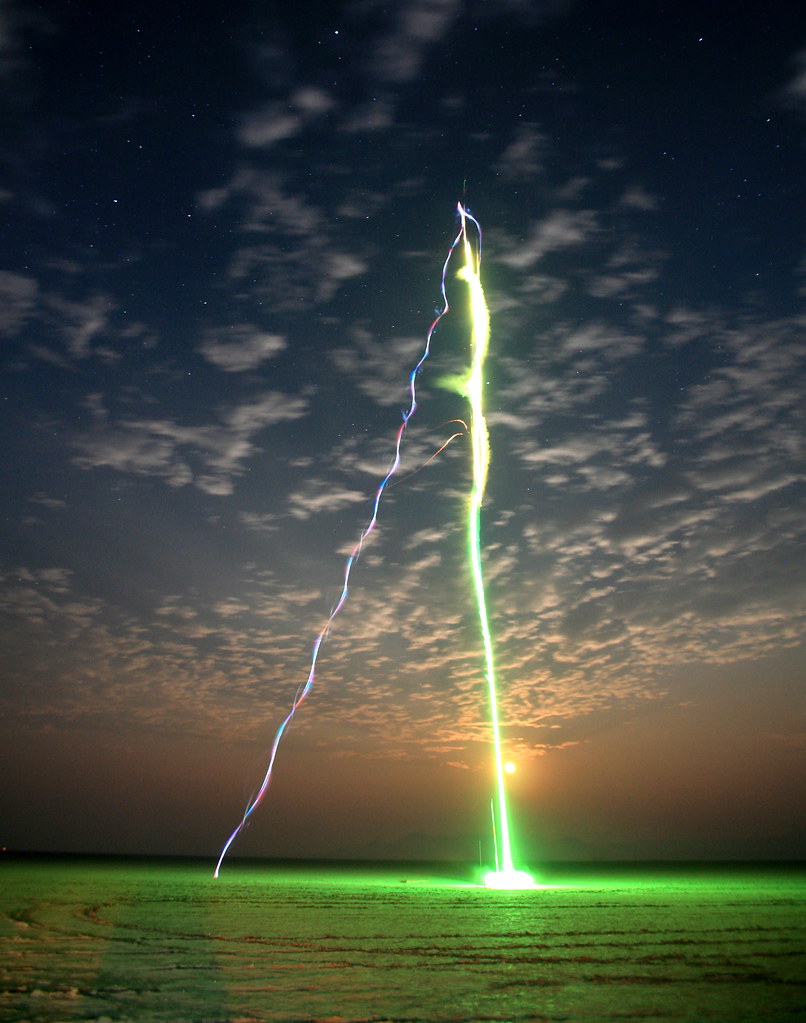I'll be launching this rocket again on Saturday... well, the upper half of it, which survived unscathed from this dramatic motor rupture a half-mile up in the moonlit sky of the Black Rock Desert:
I just love night launches as you can get a time-lapse capture of the entire rocket flight, especially when something goes haywire.
The Aerotech Green Mojave propellant burned brightly, lighting up the playa and the neighboring launch rails, but it also burned through the center of the forward closure (melting aluminum) and torched the electronics of the bottom section... and even burnt right through the "fire-proof" kevlar that was holding the top and bottom half of the rocket together. So the two sections separate mid-way and both are unstable. The bottom half goes into a corkscrew and then fades to darkness. The nose cone, luckily, is still connected to the HCX flight computer and avionics bay which operates like a charm and detects apogee and pops the chute as programmed (there is a fire-block between the bottom and top half, so the upper half is in perfect shape). Near apogee, there is some white smearing as the parachute deploys with white spotlights illuminating it from below.
Then the nosecone and avionics bay drift back to the playa (to the left) at a fairly constant speed, so the blinking light pattern makes a spiral candy cane in the sky.
Luckily the nose and computer bay survived this launch, and only the bottom half burned out. I built a fiberglass Nike Smoke rocket that will provide a new bottom half for Saturday's night launch. We can rebuild her... We can make her stronger, bigger and blinkier than before...
I was reminded at how tough this little rocket is. In the prior launch, the parachute charge did not ignite and so it lawn-darted into the desert playa. In that flight, it only lost the nose cone. That is quite a ballistic impact into hard clay. You can see those photos at the bottom of my EMRR rocket review. I built a new nose cone and added an avionics bay section for a flight computer since that review (I did not want to rely on motor ejection again for parachute deployment).
Photo details: 14 second exposure, f2.8, 16mm, ISO 800 Canon 5D, bulb mode, manual focus done earlier when the sun was still up... and the horizon could still be seen and made level. I knew where the moon would rise (roughly) from the prior night. So I left my tripod there for a few hours until it got dark enough. Single digital exposure, no Photoshop as with all my shots.â¨â¨I held it open in bulb mode with manual focus and went with my gut on the settings. The first shot was way overexposed. And the next two took my breath away. I like this one the most; it was the third of the bunch, and I was trying to use the red moon to light up the scattered clouds a bit more... and I had the rare benefit (photographically speaking =) that my rocket motor ruptured mid flight !

Absolutely beautiful! I'd love to see more time lapse photography of launches like this.
Pretty hard for us non-rocket non-scientists to figure out the scale of this picture...
At what altitude did the sections go their separate ways?
Love the shot! What all lighting the parachute trip back to firma? (some LEDs on the flight avionics maybe?)
Also, about shipping these engines around, I'm guessing they can't retail them through USPS. Do they have a special shipping service?
Eronarn - you got it. I'll see what I can capture Saturday, and pull a sampler together.
Pierce - It's tough for all of us. The 16mm wide angle lens captures a huge piece of the sky. It was about 2000 ft up. If it had not had a "premature evacuation", the rocket would have streaked off the frame.
Spiv - G size motors and below can be shipped fairly normally. The bigger motors have a hazmat fee and must ship ground transport (not too expensive though). For the O size motors and above, it's nuts and the shipping fees exceed the cost of the motor. O motors are used as cruise missile boosters. They have to shut down traffic in both directions on all bridges that the shipping truck crosses! So, most people brew their own motors at that size (you have to anyway for a Q or R motor).
spiv - forgot to answer the lighting question. Yes, it has 22 dancing LED triplet lights in the nose and body, and a custom mod of 4 super-bright white LEDs to light up the white satin parachute.
You can see it dancing here: www.flickr.com/photos/jurvetson/859477057/#comment72157600954022324
Stunning photo, in so many ways.
Spiv - G size motors and below can be shipped fairly normally. The bigger motors have a hazmat fee and must ship ground transport (not too expensive though). For the O
Photo details: 14 second exposure, f2.8, 16mm, ISO 800 Canon 5D, bulb mode, manual focus done earlier when the sun was still up... and the horizon could still be seen and made level. I knew where the moon would rise (roughly) from the prior night. So I left my tripod there for a few hours until it got dark enough. Single digital exposure, no Photoshop as with all my shots.â¨â¨I held it open in bulb mode with manual focus and went with my gut on the settings. The first shot was way overexposed. And the next two took my breath away. I like this one the most; it was the third of the bunch, and I was trying to use the red moon to light up the scattered clouds a bit more... and I had the rare benefit (photographically speaking =) that my rocket motor ruptured mid flight !
thanks...